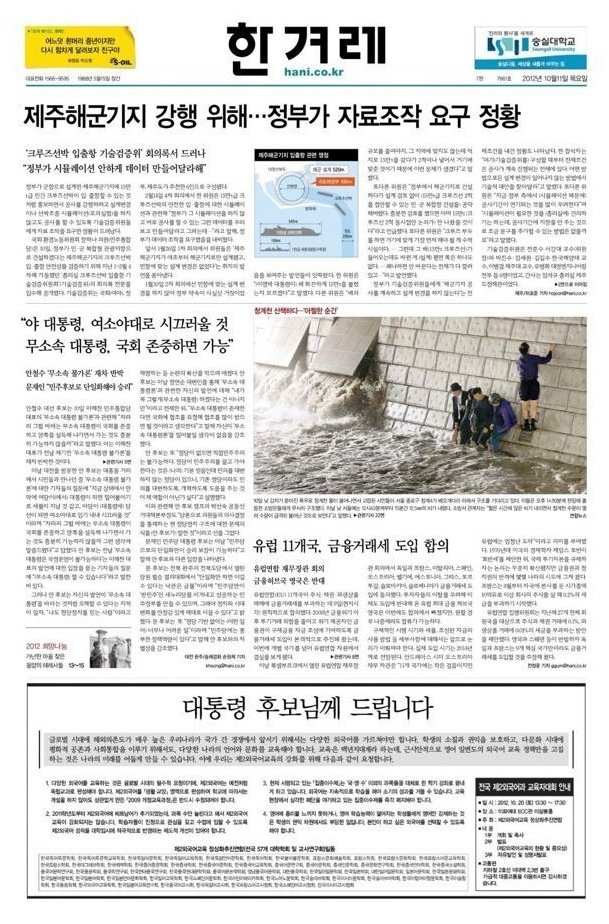
Base opponents now have concrete and irrefutable evidence to back up what they have suspected and declared for a long time. Assembly Woman Chang Ha-na has found and disclosed the full record of the meetings between the Prime Minister’s office and the Technical Committee, revealing publicly the complete lie of the so-called “civilian military dual use port”, as well as the general deception, and poor and hurried planning behind the Jeju Naval Base Project.
Evidence Shows Government Ordered Data Doctored on Jeju Naval Base; Committee recommended simulation tests, but construction was rushed ahead
By Heo Ho-joon, Hankyoreh Jeju correspondent
Evidence suggests that the government ordered data to be doctored to allow for the construction of a controversial naval base on Jeju Island without conducting simulation safety tests for cruise ships entering and exiting the base.
Accounts from members of the technical committee examining the base, ostensibly a joint civilian-military “tourism harbor,” suggest it was designed as a military port, with the simulations planned only to give the appearance that it would also be accessible to 150,000-ton cruise ships.
Democratic United Party Rep. Chang Ha-na, who sits on the National Assembly’s Environment and Labor Committee, disclosed full records on Oct. 10 from four meetings of a technical committee under the Office of the Prime Minister that convened in January and February to examine the port’s suitability cruise ship entry and departure. The six-member committee had six members recommended by the ruling New Frontier Party, the opposition, the administration, and the province of Jeju.
At the fourth meeting on Feb. 14, one committee member hinted at government doctoring of the data for a simulation on the port’s safety for 150,000-ton cruise ships.
“The government’s telling us to come up with data that would allow construction to begin right away without a simulation,” read the records of the technical committee’s meetings.
Also, at the first meeting on Jan. 26, members of the committee made statements to suggest that the port was originally designed as a naval base, with no design changes to make it suitable for use as a civilian harbor.
Statements made at the second meeting on Jan. 30 indicate that the design changes in question were not made, showing the government’s pledge to have been false.
One committee member said, “I have no idea why [President Lee Myung-bak] gave that wild figure of 150,000 tons.”
“You would need to make the boats smaller,” a second responded. “It doesn’t work for that region. The problem is that they had to go claim it could accommodate two 150,000-ton boats and design it around that.”
A third said, “So the government was building a naval base and it went ahead and made the pledge [for a civil-military harbor capable of accommodating two 150,000-ton cruise ships] without examining the design at all. If they’d looked closely enough, then maybe this 150,000-ton stuff would never have been said.”
A fourth said, “If you’re building a cruise dock, the first thing you need is harbor facilities. . . . They’ve got boats that size [150,000 tons] coming in here, and nothing’s changed with the surface. . . . And the reason is there’s an underlying assumption nothing’s going to be changed.”
The committee was chaired by Sogang University professor Jeon Joon-soo and included Korea Maritime University professors Park Jin-soo, Kim Se-won, and Kim Gil-soo, Cheju (Jeju) National University professor Lee Byung-gul, and DY Engineering executive director Yu Byeong-hwa. The secretary was Im Seok-gyu, Jeju policy officer for the Office of the Prime Minister.After four meetings, the committee concluded with the recommendation that a vessel simulation was needed to take into account the repositioning of harbor structures and placement of tugboats without major changes to the existing harbor design, and was then disbanded.
Since the committee’s fruitless discussions and non-binding conclusion, the government and Navy have pushed ahead with the construction, conducting no simulations and making no design changes to date. The project is currently 22% complete, according to the Navy.
Other evidence surfaced to suggest the committee members were told that the construction would continue and there would be no design changes.
One member said, “Ever since they set this [committee up], there has been the assumption that the construction would be going ahead all the while. They’re asking us to find some kind of technical alternative that wouldn’t require any design change.”Another member responded, “Right now, the government’s worried that the construction is going to be delayed” by a simulation.
The same member said, “We advised [the Office of the Prime Minister] that a simulation was needed, and they said, ‘Can’t you just put a little phrase in there or something without messing up the construction timetable?’”
Chang declared that the meeting records bore out suspicions that the government and military planned the harbor as a military port and looked for a way around the 150,000-ton cruise ship issue after the President made his remarks.
“They need to halt the naval base construction and reexamine [the port] from square one,” she added.
Please direct questions or comments to [english@hani.co.kr]

